Woodstock
Woodstock Music & Art Fair presentsAn
Aquarian Exposition3
Days of Peace & Music
The Woodstock Music & Art Fair presents An Aquarian Exposition - 3 Days of Peace & Music, Woodstock for short, was an open-air music festival. It is considered to be the high point and at the same time the end point of the hippie movement in the USA, which had reached the mainstream.
The festival took place as scheduled from August 15 to 17, 1969, but did not end until the morning of August 18. The venue was a dairy farmer's pastureland in White Lake near the small town of Bethel in New York State, about 70 kilometers southwest of the eponymous and originally intended venue in Woodstock.
In front of an estimated 400,000 visitors, 32 bands and solo artists of the music genres folk, rock, psychedelic rock, blues and country performed, including stars like Jimi Hendrix, Janis Joplin and The Who. The expected audience numbers were exceeded by more than double. Countless potential spectators were also stuck in traffic jams around the festival grounds. During the event, conditions were at times catastrophic due to bad weather and organizational abuses. Despite these adverse conditions, Woodstock has become known for its peaceful atmosphere. Numerous musicians, staff and visitors spent the festival days under the influence of drugs such as LSD, mescaline, hashish and marijuana.
Although guided by commercial interests of organizers, band managers and many musicians, Woodstock embodies the myth of a peace-loving, artistic and "different" America. In contrast, a divided America found itself in the Vietnam War, shocked by political assassinations of John F. Kennedy, Malcolm X, Martin Luther King, and Robert F. Kennedy, and under the impact of social conflicts thematized by the counterculture.
The Oscar-winning film Woodstock, which was made at the festival, is considered one of the most successful documentaries and was partly responsible for transporting the myth of Woodstock to the world.
History
Previous story
Contrary to popular myth, the Woodstock Festival was a thoroughly commercial event. Young New York rock managers, festival promoters and music producers Artie Kornfeld and Michael Lang, along with venture capital investors Joel Rosenman and John P. Roberts, were the initiators, organizers and driving background forces behind the Woodstock Festival.
Originally, the 24 and 26 year old duo Lang/Kornfeld only wanted to stage a concert to effectively promote the opening of their planned sound and recording studio, which they planned to build together at Michael Lang's home in Woodstock. Lang and Kornfeld expected to make a good deal by supplying the recording studio infrastructure virtually free of charge and on site for the numerous popular and high-revenue artists of the folk and rock music scene who had also settled in and around Woodstock at the time. Bob Dylan had retreated to the small town about 160 kilometers north of New York City in 1966 after his motorcycle accident. He was followed by stars of the time such as Janis Joplin, Jimi Hendrix, Blood, Sweat & Tears and The Band.
To finance the recording studio, the hippie duo Lang/Kornfeld met the financial entrepreneurs Joel Rosenman and John P. Roberts, both of the same age. Rosenman and Roberts, who came from New York's upper class, had previously placed an ad in the Wall Street Journal touting themselves as "young men with unlimited capital" in search of investment opportunities.
Through the intermediary of attorney Miles Lourie, the four met for the first time on February 6, 1969, at the apartment Rosenman and Roberts shared on 85th Street east of New York's Central Park, to discuss financing the Woodstock recording studio. According to Lang and Kornfeld's plans, a concert was to be given at the studio's opening so that invited members of the media could promote the project. Roberts and Rosenman, however, were no longer interested in funding another recording studio, as they themselves had just invested in the construction of the Media Sound recording studio complex set up in a former church on 57th Street.
Instead, they suggested Lang and Kornfeld expand the concert to a two-day music and arts festival. Lang and Kornfeld could then use the resulting profit to finance the recording studio. An initial budget of $250,000 (2021: approximately $1.7 million) has been estimated - to cover the costs of performance fees for the musicians, for the organization, and for the stage infrastructure. With an expected 100,000 visitors on both days, a net profit of between 250,000 and 300,000 US dollars was calculated at an average ticket price of 5 US dollars. However, the festival was extended by another day and from then on 200,000 visitors were expected. The date was set for 15 to 17 August 1969.
Preliminary planning
On February 28, 1969, the company Woodstock Ventures Inc. was founded with offices on 57th Street, in which the four protagonists each had a 25% share. In accordance with their abilities, Michael Lang took over all the work necessary for the production, such as hiring the artists, setting up the stage, the sound system and the lighting. Lang, who had put on the Miami Pop Festival a few months earlier, leaving behind a financial disaster, hired head coordinator Stanley Goldstein to assist.
Kornfeld took over public relations and brought PR professionals Jane Friedman, Danny Goldberg, Mike Forman and Bert Cohen to Woodstock Ventures. Kornfeld's advertising strategists made sure that the festival was advertised on every radio station, in newspapers large and small, not only across the U.S., but also in Canada and Europe - and was thus largely responsible for the rush of visitors.
Joel Rosenman and John Roberts were responsible for financing, administration, insurance, ticket and program production, pre-sales and box office. Several attorneys were brought in to assist with any legal or statutory issues.
The event was originally scheduled to take place at the 300-hectare Winston Farm in the small town of Saugerties, about 15 kilometres east of Woodstock, in the US state of New York. However, the residents of the small town successfully opposed the expected hippie onslaught, and so the organizers received the unexpected cancellation of the intended festival venue. The same happened to the organizers with an industrial site in the small town of Wallkill that had been chosen as a venue in the meantime. On July 2, 1969, a citizens' action group obtained a local ordinance banning the festival from being held in Wallkill.
Venue
It was not until July 15, with the support of Elliot Teichberg, that the village community of White Lake, located 70 kilometers southwest of Woodstock in the Catskill Mountains near the small town of Bethel in the US state of New York, was found as a venue. Teichberg was the only person in the community with a license to host musical events, which he had issued to himself as president of the local chamber of commerce. He rented Lang and Kornfeld his parents' El Monaco Motel, which was converted into a production and event office. During the festival, the motel also served as an "emergency room for bad LSD trips." Director Ang Lee later filmed the story of Teichberg's involvement under the title Taking Woodstock.
According to Teichberg, he also helped the organizers arrange for a sprawling 240-acre site to host the festival for the expected crowds. Teichberg, through middleman Morris Abraham, put Michael Lang, head coordinator Stanley Goldstein, and Bethel-based dairy farmer Max Yasgur in touch with each other about appropriate land. Lang and Goldstein were excited about a gently sloping 150,000-square-foot pasture that was nestled into the landscape like an amphitheater, making it perfect for a concert event. In addition, other fields surrounded this pasture for use as camping facilities and parking. Yasgur received $50,000 (2021 approximately $350,000) for the cow pastures it provided. Yasgur secured an additional US$75,000 bond from the organizers to cover any claims for damages. Yasgur later faced claims for damages in the amount of US-$ 35,000. In addition, Yasgur leased the lake Filippini Pond from poultry farmer William Filippini for $5,000. Filippini Pond was adjacent to the festival grounds and served as a drinking water reservoir and swimming area for crew and visitors during the festival days.
The local restaurateurs and the president of the Bethel business association welcomed the event. 800 citizens of the small town, on the other hand, signed a petition against hosting the festival and the expected mass influx. They could only be pacified with checks in an undisclosed amount from Joel Rosenman. Another banishment from the festival site by means of another citizen uprising would have meant the certain end for the event.
Within three remaining weeks, engineer Chris Langhart, hired as technical director, had to build a festival-ready infrastructure with the help of 400 craftsmen, including new roads, power lines, telephone lines, wells, water pipes and the festival stage with light and speaker towers. Musicians had to be recruited for the new venue, which sometimes entailed costly contract renegotiations. In addition, a traffic and security concept had to be worked out. Ticket holders and potential festival goers had to be told that the venue had changed from Wallkill to White Lake/Bethel, as the festival had long been advertised as being at Wallkill in promotional ads. In addition, Artie Kornfeld had advertisements placed in 250 underground newspapers for the Festival for Peace and Music now being held in White Lake/Bethel.
Tickets and the way to the Free Concert
Ticket sales for the festival were advertised under the slogan Woodstock Music & Art Fair presents An Aquarian Exposition - 3 Days of Peace & Music. This leitmotif thematized the dawn of the Age of Aquarius - a widespread belief among hippies, based on astrology, that a new age full of love and peace had begun.
The cost of a three-day ticket in advance was $18 (2021: $130). A one-day ticket cost US$7 (2021: US$48). 186,000 tickets were sold in advance, generating proceeds of US$ 1.8 million (2021: US$ 12.5 million). On site, the organizers should charge 8 US-$/day ticket or 24 US-$/three-day ticket.
Already two weeks before the festival started, the first visitors came to the site and settled down in tents and caravans. This happened at a time when no fence or access controls had yet been erected. The influx of visitors did not stop and increased daily. Two days before the festival started, 30,000 people were already camped out next to access road 17B, which was backed up to the Highway 17 exit in Monticello, 15 kilometres away, due to the lack of police. Shortly after, all five access roads were blocked and traffic backed up for up to 27 kilometres.
Since there had been a delay in setting up the ticket booths until the very end and fencing had been trampled down, on Saturday morning the head lighting guy Chip Monck, who also served as the announcer, took the main stage and announced to thunderous applause: "From now on, the concert is free!" Promoter Michael Lang, when asked why the decision was made to make Woodstock a free concert, replied, "It wasn't a decision. We acknowledged the facts. People always say we opened the gates to the festival grounds. But there were no gates. There were 150,000 people sitting on the site on Friday morning and the ticket booths weren't even set up yet." With the ticket booths deserted, powerful music and band manager Bill Graham threatened organizers not to let his band, the Grateful Dead, perform unless their fees were paid immediately. This demand was joined by The Who. They feared that the promoters would not be able to meet their fee obligations. To prevent these cancellations, the local bank manager was brought in from the weekend to bring in certified cash checks by helicopter.
Finances and balance sheets
The organization and staging of the Woodstock festival ultimately consumed US$ 2.7 million (2021: US$ 19 million), the major part of which was financed by Rosenman and Roberts. Rosenman and Roberts also financed and organized the largely free catering for the nearly 400,000 visitors. In addition, further food and medical care for the visitors as well as the musicians themselves had to be flown in by helicopter due to congested access roads. The festival initially became a financial failure. According to the organizers, at the end of the festival they had to cope with a deficit of 1.3 million US $. The bank considered opening insolvency proceedings on the company Woodstock Ventures, which would have deprived many musicians of their fees and suppliers of most of their receivables. To avert this from their son, the wealthy parents of John Roberts stepped in with a lightning loan, which had to be paid off by him and Rosenman over years.
| Statement of event costs | ||
| Cost (1969) | Cost (2021) | Output item |
| $800,000 | US$5,600,000 | Production costs (incl. wages for 1000 workers) |
| US$600,000 | US$ 4,200,000 | unforeseen expenses for helicopter, medical care and meals |
| US$500,000 | US$3,500,000 | relocation-related costs from Wallkill to Bethel |
| $200,000 | US$ 1,400,000 | Sound and stage lighting |
| $200,000 | US$ 1,400,000 | Advertising |
| US$155,000 | US$ 1,100,000 | Artist fees |
| US$65,000 | $450,000 | Liability insurance |
| $50,000 | 350,000 US | Lease for the festival area to Max Yasgur |
| US$25,000 | 170,000 US | 25 percent refund for 4062 unused ticket holders |
| US$18,000 | 130,000 US | Telephone lines for the Wallkill site |
| US$18,000 | 130,000 US | Telephone lines for the Bethel site |
| US$16,000 | 110,000 US | Charter fee of a Boeing 727 for the journey of the hippie commune Hog Farm |
| $10,000 | US$70,000 | Partial payments to the radical left (Yippies) |
| US$5,000 | US$35,000 | Further lease payments |
Shortly after the festival, under pressure from the lending Roberts family, the Lang/Kornfeld duo was forced out of Woodstock Ventures and compensated with $31,750 each (2021: $220,000). Thus, after paying out their shares in the business, Lang/Kornfeld no longer shared in rights and royalties income. The royalty share in the Woodstock film, which later won an Oscar and was considered one of the most successful documentaries of all time, was only 20% for the two remaining shareholders Rosenman/Roberts. The remaining 80% went to Warner Bros, producer Bob Maurice and director Michael Wadleigh. Rosenman/Roberts were only entitled to 0.5% for the exploitation of the film soundtrack, as the managing director of Atlantic Records, Ahmet Ertegun, had secured the rights in advance for US$25,000.
In 1974, income from ticket sales and the exploitation of rights amounted to $3.3 million, while expenses totaled $3.4 million. With the help of the royalties from the film as well as the soundtrack and the Woodstock Live album, the mountain of debt could finally be paid off by 1980. Since then, Rosenman/Roberts and Michael Lang, who re-entered the company with a minority shareholding on the occasion of an anniversary concert, have generated millions of dollars in profits from Woodstock with Woodstock Ventures through licensing for merchandising and image and sound rights. The world's largest merchandise licensee Live Nation Merchandise alone generates between 50 and 100 million US $ with Woodstock products in some years.

Woodstock visitors on an access road
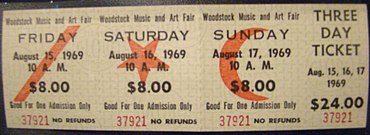
Three-day ticket (box office on site)
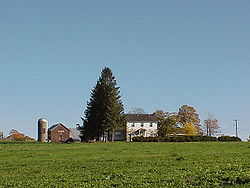
Max Yasgur's farm in Bethel in the US state of New York
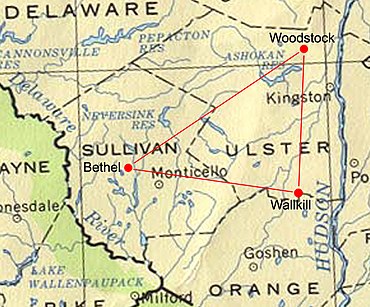
⊙42 .034668-74 .105313Woodstock , originally named venue ⊙41 .477525-74 .36358Wallkill , interim planned venue ⊙41 .701389-74 .880278White Lake / Bethel , actual event location.
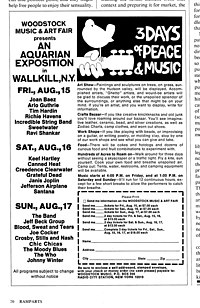
Advertisement, May 22, 1969
Festival Schedule
Friday and night to Saturday
| Friday, August 15, 1969 | ||||
| Band/Artist | Performance time | Gage (1969) | Value (2021) | Note |
| Richie Havens | 17:07-18:00 | US$6,000 | US $42,000 | |
| Swami Satchidananda | 18:10-18:20 | - — | - — | Opening Speech |
| Sweetwater | 18:30-19:10 | 1,250 US $ | US$9,000 | |
| Bert Sommer | 19:20-20:15 | US$7,500 | US$52,000 | |
| Tim Hardin | 21:20-21:45 | US$2,000 | US$14,000 | |
| Ravi Shankar | 22:00-22:35 | US$4,500 | 31,000 US | Performance in the rain |
| Melanie | 22:50-23:20 | 750 US-$ | US$5,200 | |
| Arlo Guthrie | 23:55-00:30 | US$5,000 | US$35,000 | |
| Joan Baez | 00:55-02:00 | $10,000 | US$70,000 | Baez was six months pregnant. |
According to the plan of organizer Michael Lang, the first festival day was all about folk and country music. At 5:07 pm the until then quite unknown folk musician Richie Havens opened the festival. He filled in for Sweetwater, who had not yet arrived. Havens received a lot of applause and played several encores until his song repertoire was exhausted. He then improvised a version of the spiritual Motherless Child ("Child Without a Mother"), to which he added a verse with the constantly repeated cry Freedom ("Liberty"). The song became an international hit. The depiction in the Woodstock film that Havens played for a total of three hours is false. In fact, he played eleven songs in about 45 minutes.
Meanwhile, Sweetwater had been flown in by helicopter along with Swami Satchidananda. They thought Woodstock was just another simple festival and were surprised by the crowds. Their instruments had been set up before Haven's performance, but no sound check had ever taken place. After Swami Satchidananda's opening speech, they played their 45-minute set and were very unhappy with their performance. It then began to rain, and Bert Sommer made his entrance along with his studio guitarist Ira Stone. They played ten songs, including the Jennifer Warnes dedicated song Jennifer and the Simon & Garfunkel cover America. As dusk fell, Tim Hardin, who was living in Woodstock at the time and whose career already seemed to be coming to an end, followed. He and his band played songs like Misty Roses and If I Were a Carpenter. On the latter, his voice broke in several places, probably due to the heavy drug influence.
Indian sitar player Ravi Shankar, who had performed at the Monterey Pop Festival before Woodstock, then took the stage. Woodstock was the last concert of George Harrison's mentor at festivals of this kind, as he increasingly disapproved of the hippies' open drug use and their attitude towards India, which expressed itself, for example, in Kamasutra parties with hashish. Around 10:30 p.m. he felt compelled to stop the gig because of the onset of heavy rain.
After Ravi Shankar the Incredible String Band should have performed according to the schedule of the stage manager John Morris. But they refused to perform in the rain and so the gig was postponed to the next day. In their place, 22-year-old folk singer Melanie performed, who said she was under the impression that she was apparently the only one not under the influence of drugs. She knew all the artists from the media, but had never seen any of them up close. This was not the only reason why she performed with severe stage fright. Melanie performed her two songs Beautiful People and Birthday of the Sun while the audience moved candles that had been handed out earlier in the darkness to the beat of the music. She later captured this moment in the song Lay Down (Candles in the Rain), which reached number four in the US charts the following year.
Afterwards, Arlo Guthrie, the son of Woody Guthrie, also from a folk background, performed. He performed Bob Dylan's Walking Down the Line, Amazing Grace and his song Coming into Los Angeles, during which he was briefly interrupted by an announcement by Jerry García. The performance by Arlo Guthrie, who was also apparently under the influence of drugs, included a monologue about something to do with a pharaoh, as one audience member recalled. He also coined one of the important phrases of the festival with his statement "New York State Thruway is Closed, Man."
Highlight and headliner of the first evening was Joan Baez. The pregnant singer used the opportunity to tell the audience about her imprisoned husband David Harris and to present the song Joe Hill. She then set aside her guitar and sang Swing Low, Sweet Chariot. As she finished her performance of We Shall Overcome, a heat storm began, with over 120mm of rain falling in about three hours.
Saturday till Sunday morning
| Saturday, August 16, 1969 | ||||
| Band/Artist | Performance time | Gage (1969) | Value (2021) | Note |
| Quill | 12:15-12:45 | 375 US-$ | US$ 2,600 | |
| Country Joe McDonald | 13:00-13:30 | US$2,500 | US$17,000 | had another gig with The Fish |
| Santana | 14:00-14:45 | US$2,500 | US$16,000 | |
| John Sebastian | 15:30-15:55 | US$1,000 | US$7,000 | unscheduled appearance of Sebastian |
| Keef Hartley Band | 16:45-17:30 | $500 | US$3,500 | |
| The Incredible String Band | 18:00-18:30 | 2,250 US $ | US$16,000 | |
| Canned Heat | 19:30-20:30 | US$6,500 | US$ 45,000 | |
| Mountain | 21:00-22:00 | US$2,000 | US$14,000 | |
| the Grateful Dead | 22:30-00:05 | 2,250 US $ | US$16,000 | |
| Creedence Clearwater Revival | 00:30-01:20 | $10,000 | US$70,000 | |
| Janis Joplin & The Kozmic Blues Band | 02:00-03:00 | US$7,500 | US$52,000 | |
| Sly & the Family Stone | 03:30-04:20 | US$7,000 | 49,000 US | |
| The Who | 05:00-06:05 | 11,200 US $ | US$ 78,000 | Gig was interrupted by Abbie Hoffman. |
| Jefferson Airplane | 08:00-09:40 | US$7,500 | US$52,000 | accompanied by Nicky Hopkins |
The following two festival days were dominated by rock music. The first concert on Saturday began at 12:15 p.m. with a 40-minute performance by the relatively unknown band Quill. The performance did not appear in the Woodstock film because the recording of the soundtrack was not synchronized with the film.
This was followed by an impromptu performance by Country Joe McDonald, who had come as a spectator that day and was not scheduled to perform until the following day with his band Country Joe and the Fish. He was quite surprised by the crowd. After telling the organizers that he didn't have a guitar with him, they got him a Yamaha FG 150 and sent him on stage with it. McDonald noticed during the first four songs that the crowd was not listening to him. He responded by doing a public F-voice rehearsal. To do this, he shouted to the audience, "Gimme an F," whereupon all conversation fell silent and the crowd shouted a loud "F" at him. When he was done with the rest of the letters "U," "C," and "K," he asked several times, "What's that spell?" He then performed his hit song I-Feel-Like-I'm-Fixin'-to-Die Rag, successfully ending his performance.
Santana, who took the stage next, had just recorded their first album. Although the crowd chanted "No Rain" and banged on various objects to prove it, the performance of Soul Sacrifice and the energetic drum solo by 20-year-old drummer Michael Shrieve was one of the highlights of the festival. The stage crew had also handed out scraps of lath for fans to bang against each other in time to the song. The band's debut album, released soon after the festival, made it into the Top 5 of the album charts in the US mainly because of the 45-minute festival performance.
The following performance by John Sebastian was improvised. Sebastian had previously been spotted backstage by Wavy Gravy, although he had not been booked for the festival at all. Sebastian was wearing wild tie-dye clothing and, by his own admission, was so under the influence of drugs that he was unable to refuse the request. As he took the stage equipped only with an acoustic guitar, he asked the audience to "Just love every person next to you and take some trash on the way back." His brief performance of some sort of rap, which was almost a parody of a hippie conversation as a result of its psychedelic state, was enthusiastically received by the crowd. When he suddenly had lyric dropouts, he stopped playing guitar and shouted "Help me!" to the huge crowd. The crowd complied with his request, allowing him to finish his piece correctly.
This was followed by the Keef Hartley Band, who were in their transition to jazz-rock. Apart from their drummer Keef Hartley, dressed as always in Indian clothing, it was the first appearance in the USA for the entire British band. Since the band is not featured in the film or on record, it wasn't until 2004 that Keef Hartley managed to obtain a recording of the concert through a fan.
Afterwards the performance of the Incredible String Band, which had been postponed from the day before, took place. According to their own information they had cancelled the gig on Friday because they used electric amplifiers for all instruments, which was too dangerous in the rain. The audience was prepared for "hard music" according to Santana and got instead psychedelic folk in blazing hot sun with the String Band. Enthusiasm was limited, and the band became the only one of the festival not to be asked for an encore. This resulted in the performance not being included in the first version of either the film or the album. The band's manager Joe Boyd therefore considered the rescheduling of the performance a missed opportunity.
The subsequent headlining performance of the blues band Canned Heat was preceded by an argument between guitarist Henry "Sunflower" Vestine and bassist Larry "The Mole" Taylor two days earlier on stage at the Fillmore West, as a result of which Vestine had left the band. The latter felt compelled to immediately hire Harvey Mandel in order to continue the tour. As they had not even been able to rehearse together, the then drummer and later bandleader Adolfo "Fito" de la Parra initially refused to appear at the festival, but was then persuaded. The band arrived at the same time as the roadies, who had managed to make their way through the chaos in a truck with their equipment, taking over 13 hours to make the trip between the Catskills and New York (normally two to three hours). The band played during Sunset and was celebrated by the crowd like few others during the festival. Their song Going Up the Country ( ![]() ) reached the top of the American charts that week and later became the unofficial anthem of the festival.
) reached the top of the American charts that week and later became the unofficial anthem of the festival.
The following performance of Leslie West's band Mountain was only the fourth live performance together of the shortly before formed band. Jerry García was unhappy with the Grateful Dead's several-hour performance, which began with St. Stephen and was soon interrupted by the band due to alleged monitor problems on stage. Due to the rain during the performance, the band reportedly suffered some power surges through their electric instruments. In retrospect, many fans felt that the band had had better performances before. Since the performance was deliberately not included in either the film or the album, many people did not know about it at all for a long time. The following performance by co-headliners Creedence Clearwater Revival also did not appear in the film or the original album, as John Fogerty and the record company Fantasy refused to do so. Fogerty considered the performance too bad to be released. Only a small portion of the audience was awake, and the band reportedly struggled with technical difficulties.
Janis Joplin performed afterward, but fans also rated her performance as one of her worst. Many felt the band's commitment was lacking, leaving Joplin unable to live up to her usual explosiveness. Her voice broke frequently. However, she did make a remark about the hippie movement that was later often quoted: "There used to be just a few of us, now there are masses and masses and masses of us." The performance was also not made public. This was followed in the early hours of the morning by Sly & the Family Stone's performance, which has been called one of the best of the festival and the highlight of Sly Stone's career, despite being held in the rain.
At 5 a.m., the British band The Who followed. Their manager at first refused to let the band perform without advance payment. Only when organizer Mike Lang threatened to broadcast this fact to the crowd by announcement could he be dissuaded from this plan. Their performance, made famous by the later film, included several songs from their double album Tommy, released in June. Activist Abbie Hoffman interrupted the performance by attempting to make a protest speech against the capture of John Sinclair of the White Panther Party. Pete Townshend shooed him off the stage; he later said that he actually agreed with Hoffman regarding Sinclair's capture. Townshend ended the gig by ritually smashing his guitar, which he then threw into the audience.
The festival was ended on this day, which had become very long due to the waiting times caused by the rain, by Jefferson Airplane. They started playing shortly after sunrise. Singer Grace Slick announced that the band would play some "Morning maniac music". Among other things, the song Volunteers was presented for the first time, which was released six months later together with the album of the same name.
Sunday and Monday morning
| Sunday, August 17, 1969 | ||||
| Band/Artist | Performance time | Gage (1969) | Value (2021) | Note |
| Joe Cocker and The Grease Band | 14:00-15:25 | 1,375 US $ | $10,000 | After the performance a thunderstorm led to a long interruption. |
| Country Joe and the Fish | 18:30-20:00 | US$2,500 | US$17,000 | second appearance of Country Joe |
| The Ten Years After | 20:15-21:15 | 3,250 US $ | US$23,000 | |
| The Band | 22:00-22:50 | US$7,500 | US$52,000 | |
| Johnny Winter | 00:00-01:05 | 3,750 US $ | US$26,000 | |
| Blood, Sweat & Tears | 01:30-02:30 | $15,000 | $100,000 | |
| Crosby, Stills, Nash & Young | 03:00-04:00 | US$5,000 | US$35,000 | |
| Paul Butterfield Blues Band | 06:00-06:45 | US$7,500 | US$52,000 | |
| Sha Na Na | 07:30-08:00 | 700 US-$ | 4,900 US $ | Drummer Jocko Marcellino was the youngest musician of the festival |
| Jimi Hendrix + Gypsy Sun & Rainbows | 09:00-11:10 | US$18,000 | 130,000 US | There were still about 35,000 people in attendance for Hendrix's performance. |
The last day of Woodstock began with the performance of Joe Cocker, who achieved the first big breakthrough in his career with his cover version of the Beatles classic With a Little Help from My Friends, which had already been released the previous year. After his performance a heavy thunderstorm started. When the storm had stopped, farmer Max Yasgur took the stage in whose fields the festival was held. He thanked the audience for helping him prove something to the world. According to him, the festival-goers had collectively proven that half a million people could come together and have nothing but fun and music. Yasgur claimed that this would be the largest gathering of people in one place ever.
This was followed by the performance of Country Joe and the Fish, who had been booked as a last-minute replacement for Jethro Tull. Even though the band had already performed at the 1967 Monterey Pop Festival, Woodstock was the highlight of their career. Again, the I-Feel-Like-I'm-Fixin'-to-Die Rag was played. Around 8:15 p.m., there was another highlight with Ten Years After's 90-minute performance. Because the rain had changed the humidity, the band had to stop after about a minute during their first song, Good Morning Little School Girl, to retune the guitars. The regular set was followed by the encore I'm Going Home, during which guitarist Alvin Lee played a nearly ten-minute solo. This was the only song of the performance that was recorded by the film crew. It had started filming with three cameras, one of which failed halfway through the performance. Therefore, for the triple split-screen version of the film, the mirrored footage from the right camera was used towards the end to fill the gap.
The gig of The Band at 22:00 was accompanied by strong fits of stage fright of the band members. The musicians of The Band were not used to such crowds. The experiences of Woodstock and the two weeks later appearance at the Isle of Wight Festival, where the musicians played together with Bob Dylan, were then processed in the song Stage Fright ("stage fright"). At 01:30 Blood, Sweat & Tears followed, who were considered one of the headliners. According to the band's manager, the performance should not have been included in the film, as the $7,500 the band had received for the performance was reportedly too little to keep the gig for the future. However, the film crew managed to record the opening track More and More before being expelled from the stage.
Although Johnny Winter's subsequent performance was filmed, he did not appear in the documentary. His manager had fallen out with the film crew, who subsequently prevented the release of the performance on the grounds that it had been "too weird". Around 3:00, Crosby, Stills and Nash followed. This performance, during which new band member Neil Young took the stage, was the formation's second live performance with the new lineup. The band members were suitably nervous and played two sets. They started with Suite: Judy Blue Eyes, an eight-minute suite about the end of the love affair between Stephen Stills and Judy Collins. They also played 4 + 20, a song that didn't appear until the 1970 album Déjà Vu.
Afterwards the Butterfield Blues Band performed, which had reformed shortly before after a studio break. Buzzy Feiten was present at the performance of the band around Paul Butterfield. For him it was the first professional performance. With their 40-minute performance, Sha Na Na became known to a wide audience. The band began to establish itself in the US-American rock-'n'-roll landscape. Sha-Na-Na were the only performers at the Woodstock Festival who were still without a record deal.
At 9:00 am, Jimi Hendrix, hired as the festival highlight, and his backing band took the stage. Hendrix had put together a new band for the festival: Gypsy Sun & Rainbows featuring Mitch Mitchell (drums), his old army buddy Billy Cox (bass), Larry Lee (rhythm guitar) and two percussionists. Hendrix's performance included The Star-Spangled Banner, his rendition of the U.S. national anthem as an appeal for peace against the backdrop of the Vietnam War, in which he musically recreated the sound of missiles hitting and soldiers dying. Hendrix's performance of Purple Haze, Villanova Junction and Hey Joe brought the festival to a close at 11:10 a.m. Monday morning with about 35,000 people still in attendance.

After the downpour

Dancing audience on Saturday
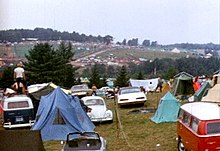
Campsite east of the stage
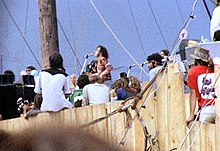
Joe Cocker's performance
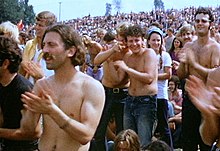
Woodstock attendees
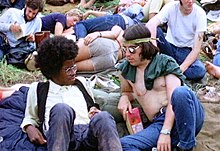
Festival-goers
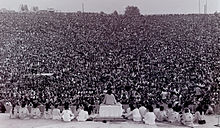
Opening Speech Satchidananda

Richie Havens' performance
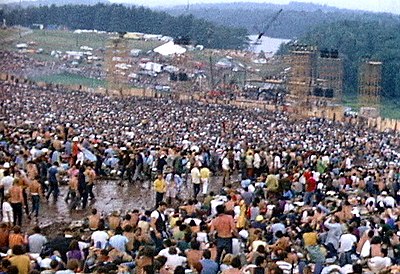
Woodstock
Questions and Answers
Q: What was the Woodstock Music and Art Festival?
A: The Woodstock Music and Art Festival was a rock music festival held at Max Yasgur's 600 acre dairy farm in the town of Bethel, New York from 15 to 18 August 1969. It is widely considered one of the most famous rock concerts and festivals ever held.
Q: Who were some of the musicians that performed at Woodstock?
A: Some of the most famous musicians that performed at Woodstock included The Who, Jimi Hendrix, Crosby Stills Nash & Young, Joni Mitchell, Bob Dylan and Janis Joplin.
Q: How many people attended the original Woodstock festival?
A: Estimates suggest that more than three times as many people attended than expected - over half a million people showed up for the event.
Q: What caused traffic jams leading up to the concert?
A: People left their cars and walked for miles to get to the concert area due to overcrowding on roads leading up to it.
Q: What did Abbie Hoffman do during The Who's set?
A: During The Who's set, Abbie Hoffman jumped on stage trying to stir up political slogans but he was knocked off by Pete Townshend's guitar which delighted the audience.
Q: How did Jimi Hendrix close out his performance?
A: Jimi Hendrix closed out his performance with a new version of "The Star Spangled Banner" which caused some disagreements due to its relevance during Vietnam War.
Q:Who organized Woodstock?
A:Woodstock was put on by Michael Lang, Artie Kornfeld, John Roberts and Joel Rosenman. Roberts was responsible for financing while Rosenman served as an amateur guitarist; Kornfeld worked as vice-president at Capitol Records; Lang owned a head shop and hoped to build a studio in nearby areas for singers such as Bob Dylan and Janis Joplin who had homes there.
Search within the encyclopedia